Cornwall’s lesser known beaches and quirky coves

Miles of coastline
Cornwall’s popular surf beaches are well known but the county also has its fair share of lesser known beaches and quirky coves waiting to be discovered.
Browse our online offers for the best prices on holiday accommodation in Cornwall and discover some heavenly hideaways for yourself.
Hawkers Cove
Hawkers Cove is a picturesque spot located near Padstow in Cornwall, England. It’s a small, sheltered bay with stunning views, crystal-clear waters, and a quiet, peaceful atmosphere, especially when compared to some of Cornwall’s more popular tourist spots. The cove is known for its sandy beach, which is visible at low tide, and for its connection to the Camel Estuary.
Hawkers Cove was once an important point for the Padstow lifeboat before the service was moved to a more accessible location due to silting issues. It’s now a serene place to enjoy walks, particularly along the South West Coast Path, offering beautiful vistas of the estuary and beyond.
Visitors often come to Hawkers Cove for a relaxing day by the sea, coastal hikes, or to explore the tidal flats. The area’s charm lies in its relative seclusion and natural beauty, making it a favorite for those looking to escape the more crowded Cornish beaches.
However, Padstow’s little hidden gem hides a dark curse. A notorious ‘Doom Bar’ of sand lies across the mouth of the estuary with Hawkers Cove on its west side. The little hamlet with its former lifeboat launch is just north of Padstow. The Doom Bar, hidden at high tide, has caused many a ship to wreck. Legend has it that it was put there by a mermaid who was shot by a mortal man. It’s said that her cries can be heard whenever a ship grounds.
Accessed via the St Merryn to Padstow Road, stop off at Lellizzick (recognisable from the Poldark opening scenes), as traffic is discouraged beyond there, then take the track to Tregirls beach and then to the coast path.
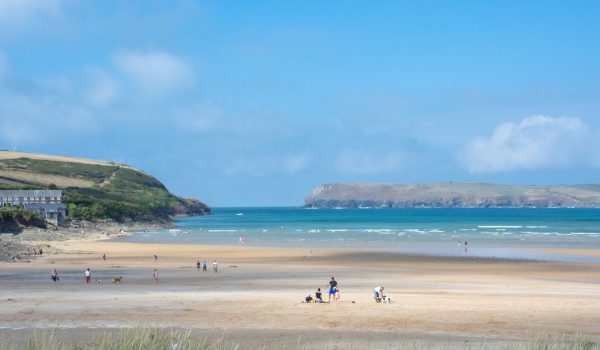 Hawkers Cove
Hawkers Cove
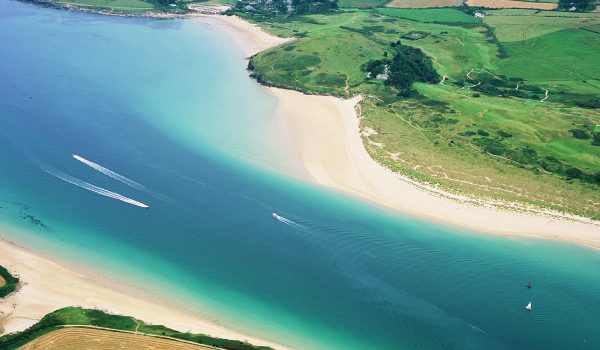 The Camel Estaury
The Camel Estaury
- Stay nearby at Bay Retreat Villas in St Merryn.
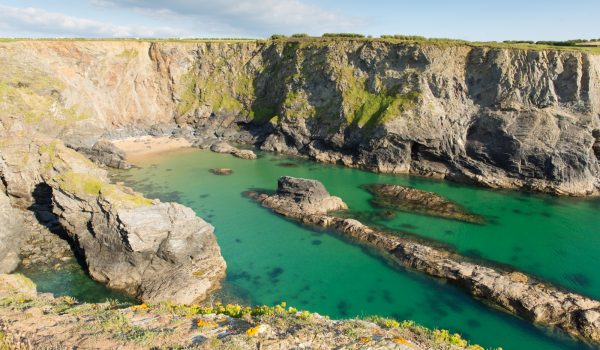 Fox Cove
Fox Cove
Fox Cove
A little further south but still on the north coast near St Merryn, see if you can find Fox Cove.
This secluded cove lies approximately halfway between Treyarnon Bay and Porthcothan. It is one of a series of rugged little inlets, the others being Pepper and Chair coves. Fox Cove is by far the best being both larger and sandier than the others.
Park at popular Porthcothan beach and then make your way across the bridge towards a coastal track. Be aware that access to Fox Cove is on the challenging side. The path down the cliff is not for the faint-hearted! The beach may be covered at high tide.
- Stay on the north coast at Beachcombers Apartments, Waves Apartments or Tregurrian Villas – all at Watergate Bay, a great base for exploring the beaches from Padstow to Newquay.
- Or choose Porth Veor Villas & Apartments for exploring further down to Penzance.
Portheras Cove
Portheras Cove is a hidden gem located on the north coast of Cornwall, England, between Pendeen and Morvah. Known for its natural beauty, this secluded cove features a sandy beach with clear waters and rugged cliffs, making it a tranquil spot away from more crowded tourist areas.
The cove is popular among locals and visitors who enjoy peaceful walks along the coastal paths and swimming in its relatively sheltered waters.
However, it’s important to note that the waters can be rough with strong currents, and there are no lifeguards on duty, so caution is advised for swimmers.
In August 1963, the Alacrity, a 454 ton cargo ship, ran aground whilst carrying anthracite from Swansea to Brussels. The remnants of the wreck were hazardous, but the debris has since been cleared.
Access to Portheras Cove requires a bit of a walk from nearby parking areas, adding to its secluded charm.
The surrounding coastline offers spectacular views of the Atlantic Ocean, perfect for photography and coastal hikes.
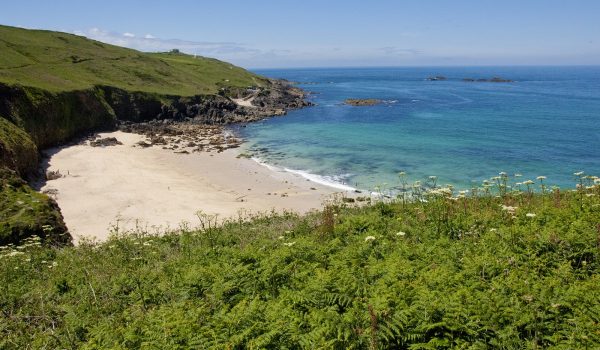 Portheras
Portheras
Gwenver
The quiet sister of famous Sennen Cove, on a clear day you can spy the Isles of Scilly from its golden sands. Tricky to access and surrounded by granite rocks, the beach is open to the wild Atlantic. Also known as Gwynver, Gwenvor or Gwenva. However you spell it, it translates from the Cornish for “white water” which is quite evident when you see the swell that it attracts!
Gwenver (also known as Gwynver, Gwenvor or Gwenva – however you spell it, it translates from the Cornish for “white water” which is quite evident when you see the swell that it attracts!) is the beautiful and somewhat secluded quiet sister of famous Sennen Cove where on a clear day you can spy the Isles of Scilly from its golden sands. Tricky to access and surrounded by granite rocks, the beach is open to the wild Atlantic. It offers a peaceful alternative to some of the busier Cornish beaches. Gwenver is known for its golden sands, dramatic cliffs, and crystal-clear waters. It’s popular among surfers due to its powerful waves, but the beach can be a bit challenging to access because of the steep path leading down from the cliffs.
Despite its seclusion, Gwenver is a favorite for those looking for a quieter and more rugged Cornish beach experience, with incredible views of the Atlantic Ocean. Because of its west-facing orientation, it’s also a great spot for watching sunsets. During low tide, you can walk from Gwenver to Sennen Cove along the shore. However, caution is advised when swimming due to strong currents.
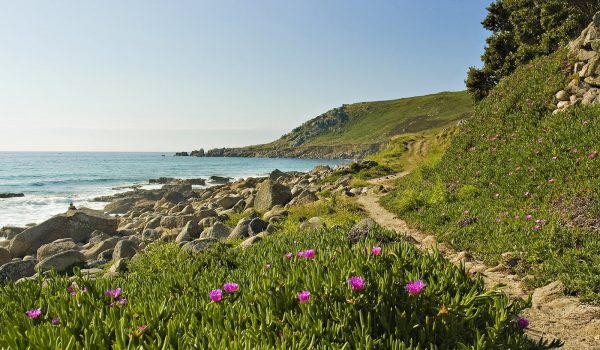 Gwenva
Gwenva
Nanjizal Bay
Park at Land’s End and walk 3 miles to be treated to this beautiful bay with its rock formations.
Nanjizal Bay is a secluded and picturesque cove located on the southwestern tip of Cornwall, near Land’s End. It is known for its rugged beauty, crystal-clear waters, and striking rock formations.
One of the most notable features of Nanjizal is a natural rock arch called the “Song of the Sea,” and the “Diamond Horse” through which light creates beautiful reflections in the water. This sandy beach with huge caves comes complete with a waterfall and stream.
The beach is relatively isolated, requiring a hike to reach it, which makes it quieter and less crowded compared to other more accessible beaches in Cornwall.
The surrounding cliffs and coastline offer breathtaking views, and the bay is a favorite spot for photographers, nature lovers, and those seeking a peaceful retreat.
Nanjizal’s remote location and its wild, unspoiled nature make it a hidden gem along the Cornish coast. This is the true Land’s End.
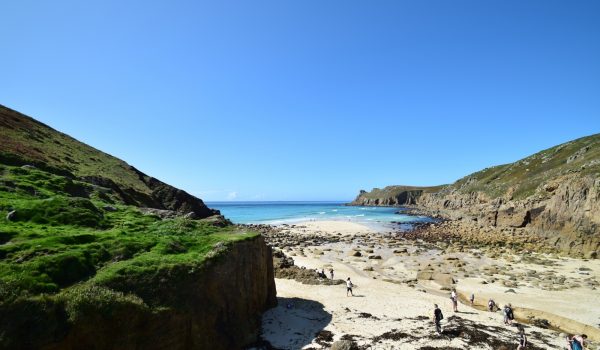 Nanjizal
Nanjizal
Pedn Vounder
Pedn Vounder is a stunning beach located on the south coast of Cornwall, near Porthcurno. It is part of the larger Penwith Heritage Coast, a protected area known for its dramatic cliffs, turquoise waters, and golden sands. The beach is renowned for its natural beauty and has gained popularity for its somewhat secluded and unspoiled character.
Pedn Vounder is accessible via a steep path from the cliffside or by walking along the shore at low tide from the nearby Porthcurno Beach. However, because of the challenging descent and the tidal nature of the beach, visitors should be cautious and aware of tide times.
The beach is also known for being clothing-optional, making it popular among naturists. The views from the cliffs above are breathtaking, and the surrounding area is a popular spot for hikers exploring the coastal paths. Pedn Vounder offers an idyllic, peaceful setting, perfect for those seeking a more remote and serene beach experience in Cornwall.
Stunningly beautiful with the tall granite cliffs of Treryn Dinas sheltering the golden sand and clear water, it’s worth the 10-minute walk from Treen to play with the 70-tonne Logan Rock which can be rocked to and fro by one person. At low tide, park at Porthcurno beach and access Pedn Vounder that way.
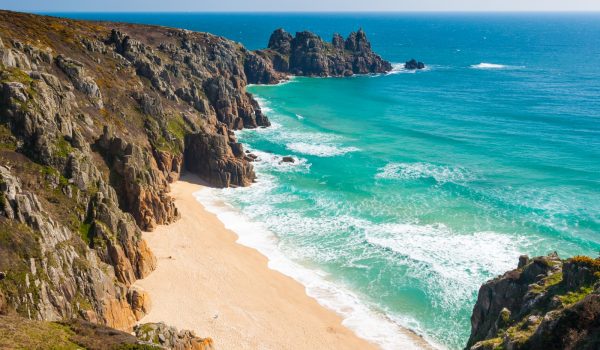 Pedn Vounder
Pedn Vounder
Kynance Cove, Pentreath beach and Housel Cove
Take a walk around the most southerly part of the British mainland at Lizard Point and you’ll see one of the most photographed beaches in Cornwall, yet still fairly inaccessible. The aquamarine water and soft white sand at Kynance Cove lend any photographer a hand. Jutting rock stacks surround the cliff edge and a small peninsula of sand remains uncovered until high tide. A network of interconnected caves reveals the coves smuggling past. However, for a truly secret beach follow the southwest coast path towards Pentreath beach and onto Housel Cove, hidden at the foot of a steep valley. Cut off at high tide, check the steps are safe before descending.
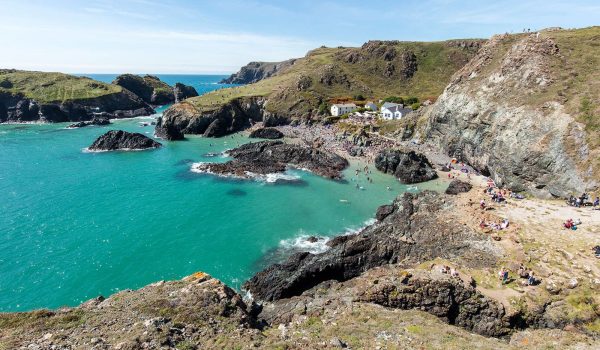 Kynance Cove
Kynance Cove
Hemmick Beach and Dodman Point
Hemmick Beach is a hidden gem located on the southern coast of Cornwall, near the village of Gorran Haven. Known for its secluded and peaceful setting, it’s a perfect spot for those looking to escape the more crowded beaches in Cornwall. Hemmick Beach is a mix of golden sands and pebbles, with dramatic cliffs and rocky outcrops surrounding the cove. The beach is backed by lush green hills, offering a picturesque and tranquil atmosphere.
Due to its remote location and challenging access, Hemmick Beach is much quieter than many of Cornwall’s more popular beaches. It’s a great spot for those seeking solitude or a peaceful day by the sea. The beach is accessed via a steep path from a small car park located a short walk away. There is a very narrow lane leading to the car park, which can be tricky to navigate. The remoteness and limited parking space contribute to the uncrowded nature of the beach.
The beach can almost disappear at high tide, so it’s important to check the tide times before visiting. Swimming is possible, but care should be taken as there are no lifeguards on duty.
Hemmick Beach is a great place for nature lovers and those looking for a more serene beach experience away from the hustle and bustle of Cornwall’s busier tourist spots. The nearby coastal path offers scenic walks, including a route to Dodman Point, where visitors can enjoy stunning views of the coastline.
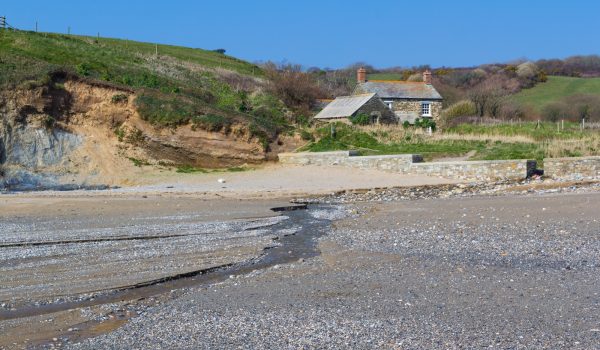 Hemmick Beach
Hemmick Beach
Lantic Bay
Lantic Bay is a beautiful, secluded beach on the south coast of Cornwall, near Fowey. Known for its striking natural beauty, the bay is part of the Polperro Heritage Coast and offers stunning views of turquoise waters, white sands, and rugged cliffs.
Accessible via a steep footpath from the South West Coast Path, the bay is often quiet, making it a great spot for those seeking peace and solitude.
Due to its remote location, visitors should be prepared for a fairly challenging walk to reach the bay. The path is steep, but the reward is the pristine, often uncrowded beach.
The bay is characterized by its crystal-clear turquoise waters, a crescent of golden sand, and steep, grassy cliffs. The beach is only accessible by a steep, rugged footpath, which adds to its secluded and untouched atmosphere.
Lantic Bay is a popular spot for hikers, picnickers, nature lovers and those seeking a peaceful, remote beach experience away from crowds. It is also known for being an ideal location for swimming and kayaking, though visitors need to be cautious of strong tides.
Once you are there, just enjoy its unspoiled charm and dramatic coastal scenery.
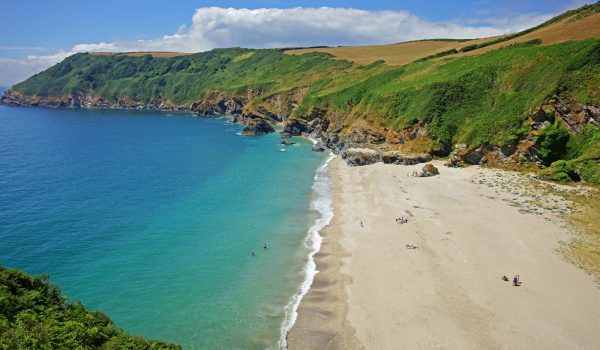 Lantic Bay
Lantic Bay
- For south coast beaches, stay at Green Acres Cottages
Not so secret but did you know..?
Porthcurno beach has a network of underground telecommunications cables laid underneath its sand which connected Britain with America. A series of World War II tunnels also runs through its cliffs which protected valuable equipment.
It is just 4 miles from Land’s End. At low tide, the beach expands to reveal more of the shoreline, and the waters are relatively calm, making it suitable for swimming. The surrounding cliffs and coastal walks also offer breathtaking views of the Cornish coastline.
The most quirky outdoor theatre is in residence on the cliffs here. The Minack Theatre sits on a jut of granite slate surrounded by subtropical gardens. On a clear day, you may possibly miss the performance though if entranced by the stunning sea views!
The theatre was founded by Rowena Cade in 1932, who designed and built it with the help of friends and local builders.
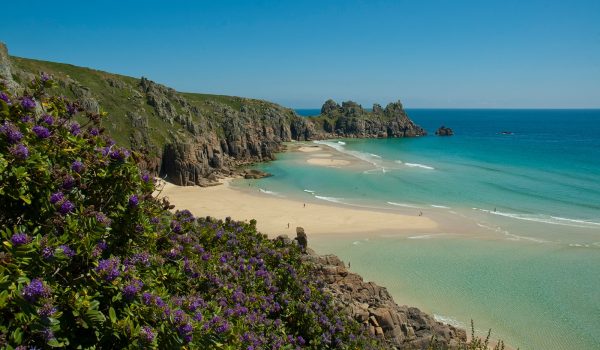 Porthcurno
Porthcurno
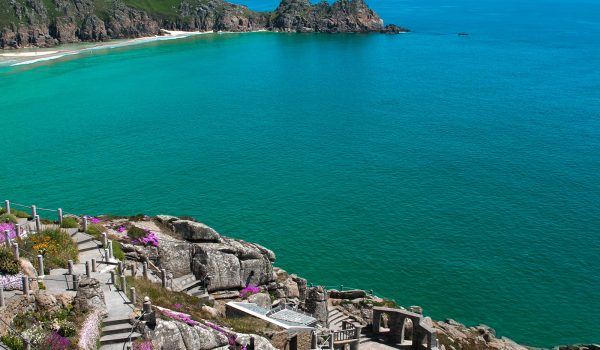 Minack Theatre
Minack Theatre
We recommend you check tide times and pay heed to warning flags as many of these secret beaches involve steep descents, strong currents, and are subject to being submerged at full tide.
You can certainly see why shipwrecking and smuggling took such a strong hold in these vicinities!



